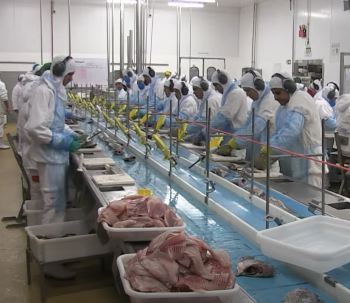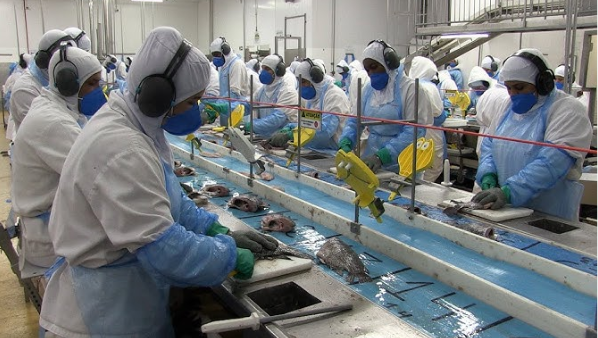|

Photo: Stockfile/FIS
Global Demand Fuels Fish Farming Boom, Attracting Meatpackers and Cooperatives
 BRAZIL
BRAZIL
Tuesday, March 18, 2025, 00:10 (GMT + 9)
Driven by the surging global appetite for farmed fish, meatpacking plants and cooperatives are aggressively expanding their aquaculture operations, fueled by optimistic projections for consumption and export growth.
.png) The potential for increased consumption and exports, particularly to the United States, the world's largest tilapia importer, is prompting significant investment in production and processing capacity. "Fish farming is the fastest-growing animal protein sector globally, a trend that has persisted for a decade," states Francisco Medeiros, president of the Brazilian Fish Farming Association (Peixe BR). He emphasizes the vast untapped potential for tilapia, native fish, and other species, as domestic consumption remains below the global average. The potential for increased consumption and exports, particularly to the United States, the world's largest tilapia importer, is prompting significant investment in production and processing capacity. "Fish farming is the fastest-growing animal protein sector globally, a trend that has persisted for a decade," states Francisco Medeiros, president of the Brazilian Fish Farming Association (Peixe BR). He emphasizes the vast untapped potential for tilapia, native fish, and other species, as domestic consumption remains below the global average.
This sentiment is echoed by companies and cooperatives nationwide, with numerous expansion projects underway.
Companies Expand for Export and Efficiency
Naturale Fish, based in Cuiabá (MT), is prioritizing export expansion. Director Juliana Medeiros highlights plans to upgrade their facility to meet international demand, aiming to capitalize on strong order volumes. Currently, they process 40 tons per month of native fish (pirarucu, pintado, and tambatinga) and tilapia.
.png) Fider Pescados, from Rifaina (SP), is also targeting the US market, focusing on fresh tilapia fillets. The company celebrates the removal of the International Health Certificate (CSI) requirement, streamlining export processes. Director Juliano Kubitza emphasizes their commitment to quality and plans to optimize logistics, reducing delivery times from 48 to 36 hours. To further boost supply, Fider is expanding its tilapia production capacity with a new farm capable of producing 8,000 tons annually, an 83% increase. Fider Pescados, from Rifaina (SP), is also targeting the US market, focusing on fresh tilapia fillets. The company celebrates the removal of the International Health Certificate (CSI) requirement, streamlining export processes. Director Juliano Kubitza emphasizes their commitment to quality and plans to optimize logistics, reducing delivery times from 48 to 36 hours. To further boost supply, Fider is expanding its tilapia production capacity with a new farm capable of producing 8,000 tons annually, an 83% increase.
The Natter Group recently opened a state-of-the-art fish slaughterhouse in Campo Verde (MT), creating 600 jobs and stimulating the local economy. The 2,000 m² facility processes 30 tons of fish daily (tilapia, pintado, and tambatinga), with plans to increase to 40 tons. Chairman Zeca Bortoli highlights the facility's advanced technology and its strategic location in a region known for poultry production. Export is a key component of Natter’s growth strategy.
Cooperatives Dive into Aquaculture
.png) In December 2024, Coopavel (Cascavel, PR) acquired Pescados Cascavel, diversifying its meat portfolio with fish processing. "The growing demand for fish prompted our entry into this market," explains President Dilvo Grolli. Coopavel plans to integrate local producers and gradually expand production, initially processing 25,000 fish per day, with the potential to reach 60,000. A dedicated fish feed plant will be built later this year, with ambitions to serve both domestic and international markets. In December 2024, Coopavel (Cascavel, PR) acquired Pescados Cascavel, diversifying its meat portfolio with fish processing. "The growing demand for fish prompted our entry into this market," explains President Dilvo Grolli. Coopavel plans to integrate local producers and gradually expand production, initially processing 25,000 fish per day, with the potential to reach 60,000. A dedicated fish feed plant will be built later this year, with ambitions to serve both domestic and international markets.
C.Vale also bolstered its aquaculture presence by acquiring Paturi Piscicultura Agroindustrial in Toledo (PR), increasing its tilapia processing capacity to 55,000 fish per day. The cooperative is further expanding its Palotina slaughterhouse with a fourth production line, aiming for a daily processing capacity of 240,000 fish, with one-third destined for export.

Regional Cooperatives Focus on Native Species
In the northern region, native fish cooperatives COPARR (Roraima) and Cooperpam (Portal da Amazônia) are pursuing expansion. COPARR, with 52 members, produces 6,000 tons of tambaqui annually and aims to expand its reach in northern Brazil and neighboring countries. Cooperpam, producing 3,500 tons of tambatinga, is focusing on strengthening exports to key domestic markets like São Paulo and Pará. Ongoing projects include building ice and feed factories, cold storage, and enhancing integration with small producers.
Source: Peixe BR Consulting
[email protected]
www.seafood.media
|



